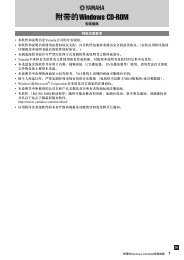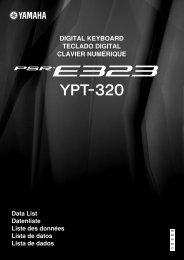You also want an ePaper? Increase the reach of your titles
YUMPU automatically turns print PDFs into web optimized ePapers that Google loves.
Other settings<br />
92 <strong>CLP</strong>-<strong>170</strong>/<strong>150</strong><br />
Selecting a scale [Scale]<br />
You can select various scales.<br />
Equal Temperament is the most common contemporary<br />
piano tuning scale. However, history has<br />
known numerous other scales, many of which<br />
serve as the basis for certain genres of music. You<br />
can experience the tunings of these genres.<br />
See the procedure on page 71.<br />
A<br />
C<br />
Setting range:<br />
Equal<br />
One octave is divided into twelve equal<br />
intervals. Currently most popular piano<br />
tuning scale.<br />
PureMajor/PureMinor<br />
Based on natural overtones, three major<br />
chords using these scales produce a beautiful,<br />
pure sound. They are sometimes used<br />
for chorus parts.<br />
Pythagorean<br />
This scale, designed by Pythagoras, a Greek<br />
philosopher, is based on the interval of a<br />
perfect 5th. The 3rd produces swells, but<br />
the 4th and 5th are beautiful and suitable<br />
for some leads.<br />
MeanTone<br />
This scale is an improvement of the<br />
Pythagorean in that the swell of the 3rd has<br />
been eliminated. It spread during the late<br />
16th century through the late 18th century.<br />
Handel used this scale.<br />
WerckMeister/KirnBerger<br />
These scales combine Mean Tone and<br />
Pythagorean in different ways. With these<br />
scales, modulation changes the impression<br />
and feel of the songs. They were often used<br />
in the era of Bach and Beethoven. They are<br />
also often used now to reproduce the music<br />
of that era on harpsichords.<br />
Normal setting:<br />
Equal<br />
If you select a scale other than Equal, you need to<br />
specify the root note using the B [–]/[+] buttons.<br />
B<br />
NO YES<br />
D<br />
Setting range:<br />
C, C � , D, E ♭ , E, F, F � , G, A ♭ , A, B ♭ , B<br />
Specifying the Split Point<br />
[Split Point]<br />
You can specify the split point (the boundary between<br />
the right-hand and left-hand keyboard areas).<br />
See the procedure on page 71.<br />
A<br />
C<br />
Setting range:<br />
A-1–C7<br />
A<br />
C<br />
NOTE<br />
You can also use [SPLIT] to set the split point. (page 36)<br />
Changing the key [Transpose]<br />
TIP<br />
TRANSPOSE= To change the key<br />
(Changing the key: To raise or lower the overall pitch of<br />
the entire song.)<br />
The Clavinova’s Transpose function makes it possible to<br />
shift the pitch of the entire keyboard up or down in semitone<br />
intervals to facilitate playing in difficult key signatures,<br />
and to let you easily match the pitch of the<br />
keyboard to the range of a singer or other instruments.<br />
For example, if you set the transposition amount to “5,”<br />
playing key C produces pitch F. In this way, you can play<br />
the song as if it were in C major, and the Clavinova will<br />
transpose it to the key of F.<br />
Setting for:<br />
Master The sound of the entire instrument<br />
(the manually-played sound and the<br />
song playback)<br />
Keyboard The manually-played sound<br />
Song The song playback<br />
B<br />
NO YES<br />
D<br />
B<br />
NO YES<br />
D




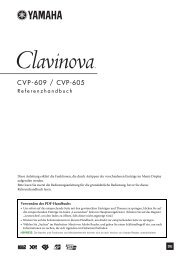

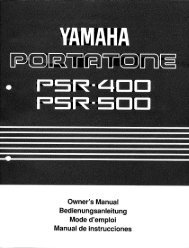

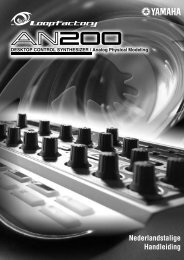
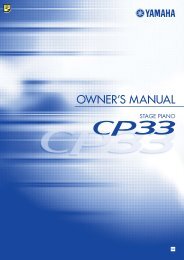





![Premere il pulsante [SONG] - Yamaha](https://img.yumpu.com/50419553/1/184x260/premere-il-pulsante-song-yamaha.jpg?quality=85)
